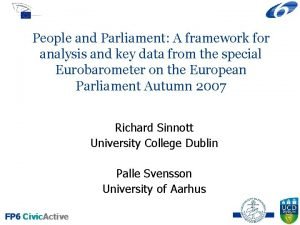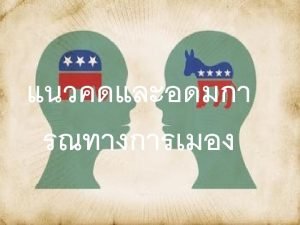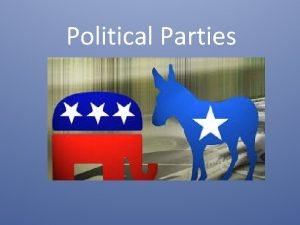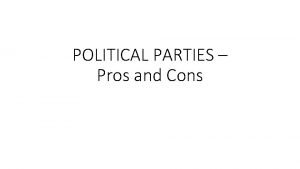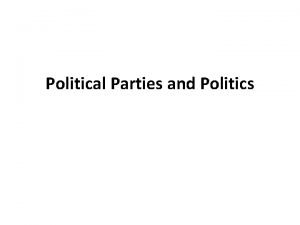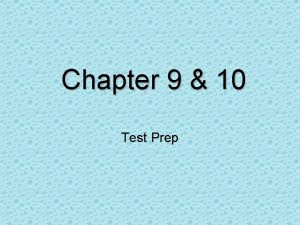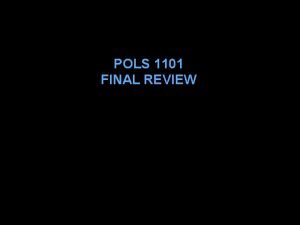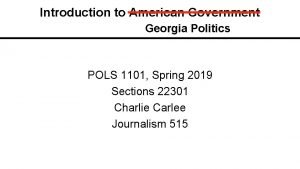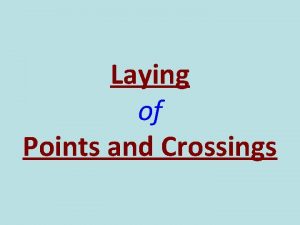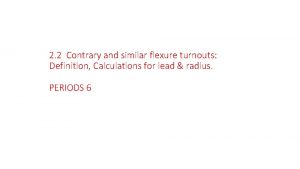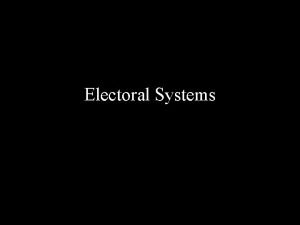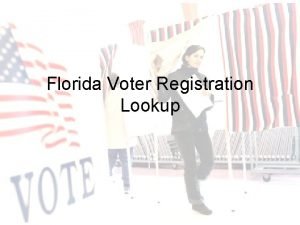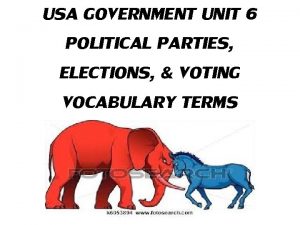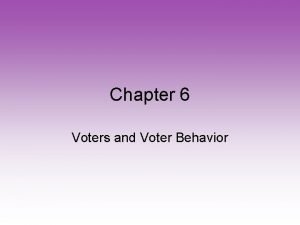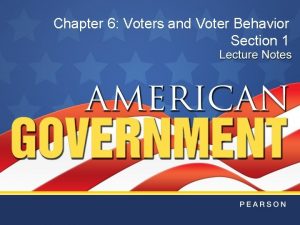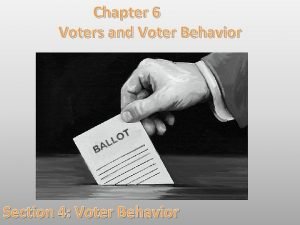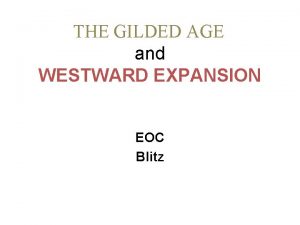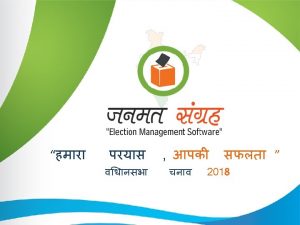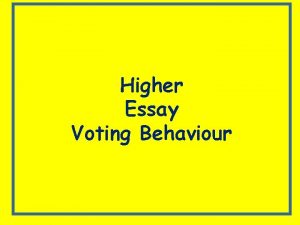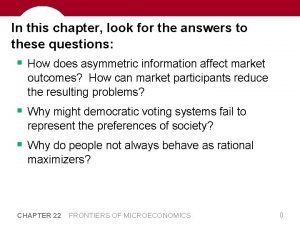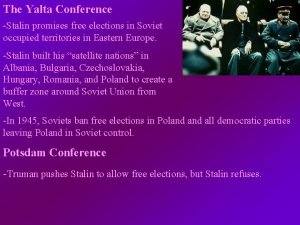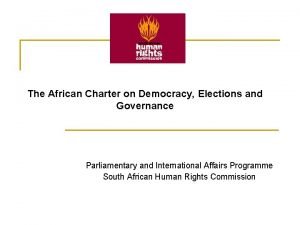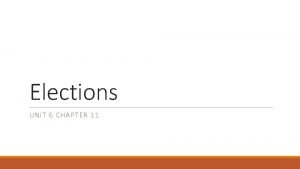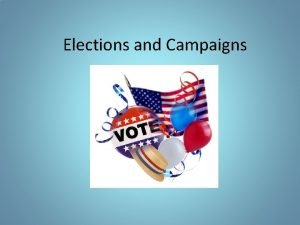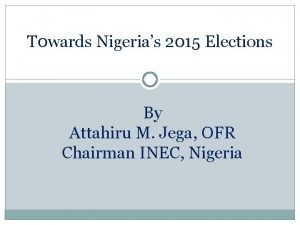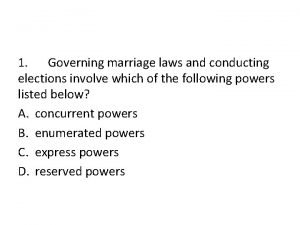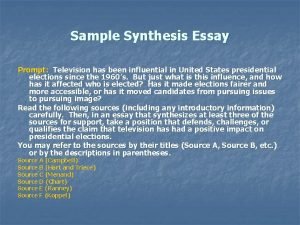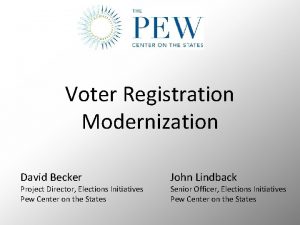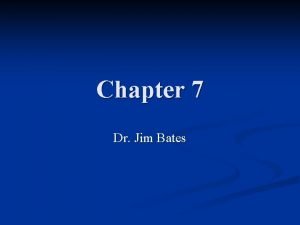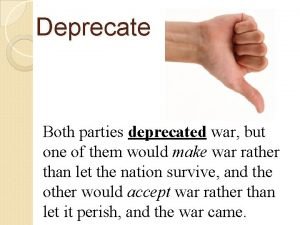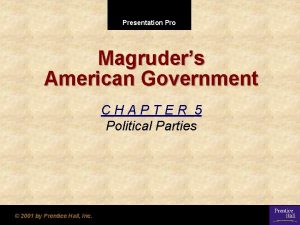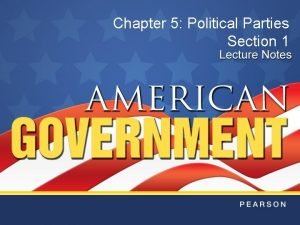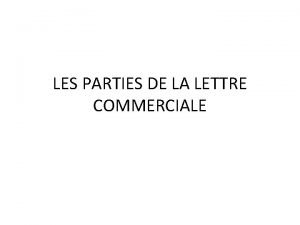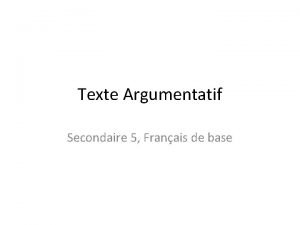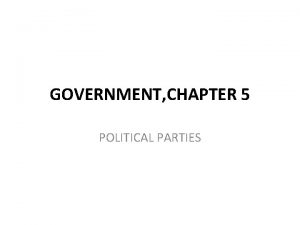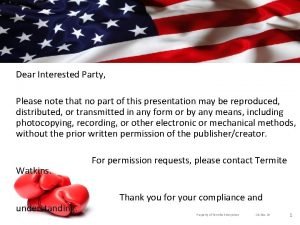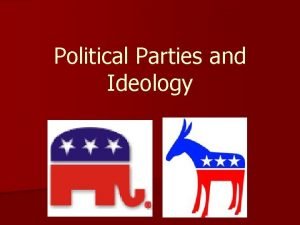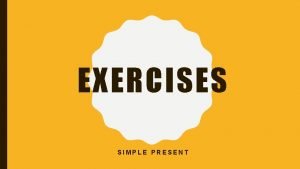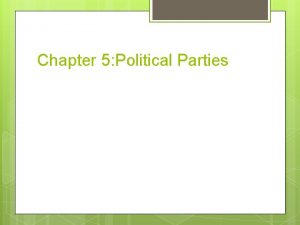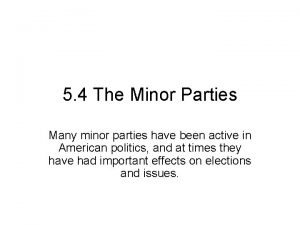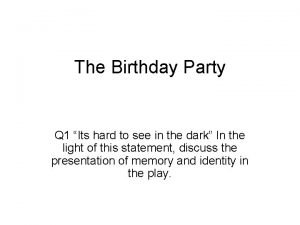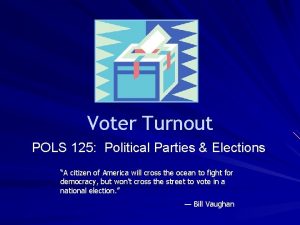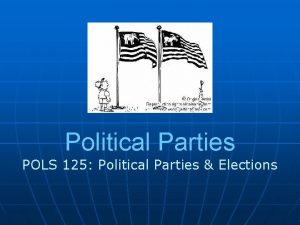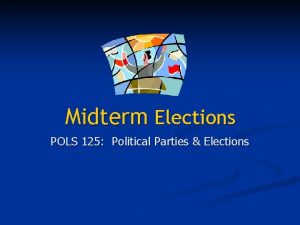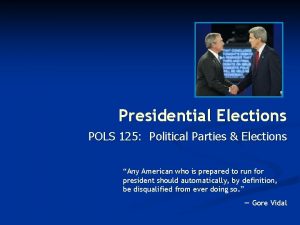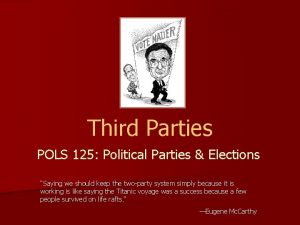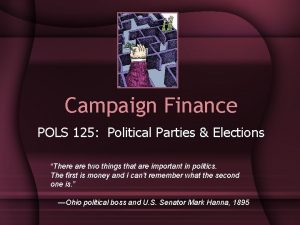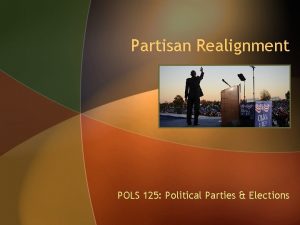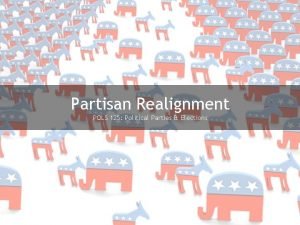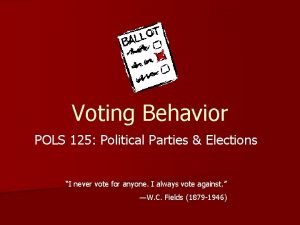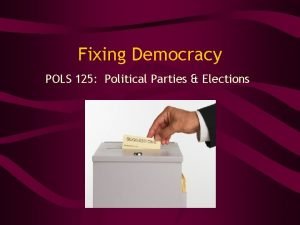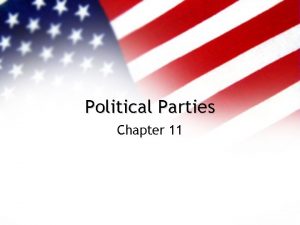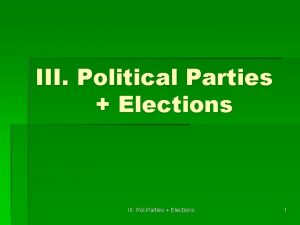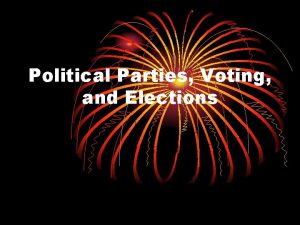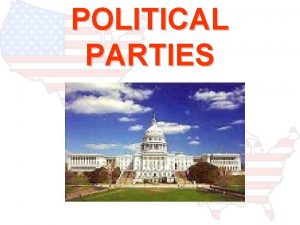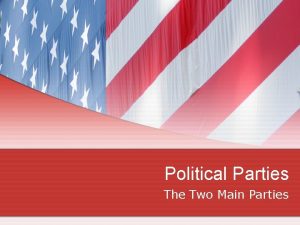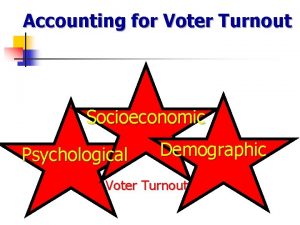Voter Turnout POLS 125 Political Parties Elections A
























































- Slides: 56

Voter Turnout POLS 125: Political Parties & Elections “A citizen of America will cross the ocean to fight for democracy, but won't cross the street to vote in a national election. ” — Bill Vaughan

Voter Turnout in 2016 In November 2016, 137 million votes were cast for president. Is that number high or low? low It depends on how turnout is measured…

The Vanishing Voter Patterson calls declining voter turnout “the longest sustained downturn in American history. ” What factors have caused it? Generational replacement Lack of competitive elections Weakening party loyalty Unsavory campaigns Negative news

This is all the more disturbing because turnout should have increased… Increasing educational attainment Removal of poll taxes and literacy tests Simplified registration procedures

How Should We Measure Turnout? Turnout statistics can use any of three denominators: The voting-age population (VAP) includes non-citizens and felons who are ineligible to vote, and excludes expatriate citizens who could legally vote overseas. VAP estimates provide the lowest turnout levels because they underestimate actual turnout. The voting-eligible population (VEP) starts with the voting -age population, then subtracts disenfranchised felons and non-citizens, and adds citizens from overseas. VEP estimates of voting turnout are higher than VAP estimates. The number of registered voters includes only those legally registered to vote. This provides the highest rate of voter turnout.

How Should We Measure Turnout? VAP VEP REG 137 million votes cast 250 million voting age citizens = 55% voter turnout 137 million votes cast = 59% voter turnout 231 million voting eligible citizens 137 million votes cast 200 million registered voters = 69% voter turnout

If voter turnout is low, compared to what? Compared to other countries Compared to historic rates of voter turnout in the United States

Voter Turnout in the United States Compared to Other Countries Worldwide

Voter Turnout in the U. S. Compared to Other OECD Countries Belgium (2014)* Sweden (2014) Denmark (2015) Australia (2016)* Norway (2013) South Korea (2017) Netherlands (2017) Iceland (2016) Israel (2015) New Zealand (2014) Finland (2015) Italy (2013) France (2017) Germany (2013) Note: Voting-age population (VAP) turnout is derived from estimates of each country's VAP by the International Institute for Democracy and Electoral Assistance. Countries listed are members of the Organisation for Economic Co-operation and Development (OECD). Mexico (2012)* Austria (2013) UK (2016) Hungary (2014) Greece (2015)* Canada (2015) Portugal (2015) Spain (2016) Czech Republic (2013) Slovakia (2016) Ireland (2016) Estonia (2015) United States (2016) Luxembourg (2013)* 55% Slovenia (2014) Poland (2015) Japan (2014) Latvia (2014) Chile (2013) Switzerland (2015)* 0. 00% 10. 00% 20. 00% 30. 00% 40. 00% 50. 00% 60. 00% 70. 00% 80. 00% 90. 00% Percent of voting age population * National law makes voting compulsory. In addition, one Swiss canton has compulsory voting. Source: Pew Research Center calculations based on data from International Institute for Democracy and Electoral Assistance, European Election Database, United States Election Project, Office of the Clerk of the U. S. House of Representatives and various national election authorities.

Voter Turnout in U. S. Elections, 1789 -2016 90 Percent of voting eligible population 80 70 60 50 40 30 20 10 0 1789 1801 1813 1825 1837 1849 1861 1873 1885 1897 1909 1921 1933 1945 1957 1969 1981 Year United States Presidential VEP Turnout Rate Source: United States Elections Project. http: //www. electproject. org United States VEP Midterm Turnout Rate 1993 2005 2017

Voter Turnout in U. S. Presidential Elections, 1789 -2016 85 Percent of voting eligible population 80 19 th Amendment grants women the right to vote 75 70 The 26 th Amendment grants 18 -20 year olds the right to vote 65 60 55 15 th Amendment grants African. American males the right to vote 50 1844 1848 1852 1856 1860 1864 1868 1872 1876 1880 1884 1888 1892 1896 1900 1904 1908 1912 1916 1920 1924 1928 1932 1936 1940 1944 1948 1952 1956 1960 1964 1968 1972 1976 1980 1984 1988 1992 1996 2000 2004 2008 2012 2016 45 Source: United States Elections Project. http: //www. electproject. org

Voter Turnout in U. S. Presidential Elections, 1960 -2016 Percent of voting eligible population 65 60 55 50 1964 1968 1972 1976 1980 1984 1988 Source: United States Elections Project. http: //www. electproject. org 1992 1996 2000 2004 2008 2012 2016

Does Low Voter Turnout Matter? Should we prefer a: Smaller, more highly educated, less representative electorate? Larger, less well educated, more representative electorate?


The reason millennials don’t vote is because politics doesn’t serve their interests. The reason politics doesn’t serve their interests is because they don’t vote.




Is voting a right or a privilege?


Increasing Voter Turnout OPTION #1: Do nothing. Once we use the appropriate measure (e. g. , VEP), there is no problem. OPTION #2: Do nothing. Turnout may be low, but we don’t want uneducated, uninformed people voting anyway. OPTION #3: Do nothing. Voter and non-voters have similar policy preferences, so it makes little difference OPTION #4: Do something!

Mobilizing the Vote Institutional context Motor-Voter Compulsory voting Election Day registration Voting by mail Internet voting Motivational strategies Personal canvassing (messenger vs. message) Social pressure Enduring personal traits and orientations Socialization through programs such as Kids Voting USA psychological

How Does Motor-Voter Work? Widely known as Motor-Voter, the National Voter Registration Act of 1993 is designed to encourage voter registration and to remove discriminatory and unfair obstacles to voter registration. As of January 1, 1995, the law requires states to register voters for federal elections in three specific ways, in addition to any other procedures they use currently for registering voters: 1. Simultaneous application for driver’s license and voter registration 2. Mail application for voter registration 3. Application in person at certain government agencies, including public assistance offices and agencies that provided services to people with disabilities

The Problem with Motor-Voter Registration Voter Turnout Motivation and/or interest in politics

Mobilizing the Vote Institutional context Motor-Voter Compulsory voting Election Day registration Voting by mail Internet voting Motivational strategies Personal canvassing (messenger vs. message) Social pressure Enduring personal traits and orientations Socialization through programs such as Kids Voting USA psychological

Playing the Margins

Voter Turnout as a Political Strategy With narrow margins of victory, and an electorate split evenly down the middle, political parties increasingly battle over voter turnout.

Obama goes door-to-door in Iowa DES MOINES, Iowa - Democrat knocked on doors in the Iowa capital Saturday talking up his opposition to the war in Iraq. At one stop, Obama got a warm welcome from a woman who said the visit might persuade her to attend the Democratic presidential caucus in January, "I'm flabbergasted that he's here knocking on my neighborhood door, " Jody Degard told reporters after the visit from the Illinois senator.

The Moneyball Campaign

Romney’s Project ORCA Instead of using paper “strike lists, ” OCRA uses smartphone technology to gather and send the data in real time. “The Obama campaign likes to brag about their ground operation, but it’s nothing compared to this. ”

“A failure and an embarrassment. And I sensed it the night before the election, when I called the 800 number for our final conference call and got a busy signal. ” Volunteers were not reminded to bring their poll watchers certificate.

Obama’s Project Narwahl “The new megafile didn't just tell the campaign how to find voters and get their attention; it also allowed the number crunchers to run tests predicting which types of people would be persuaded by certain kinds of appeals. Call lists in field offices, for instance, didn't just list names and numbers; they also ranked names in order of their persuadability, with the campaign's most important priorities first. About 75% of the determining factors were basics like age, sex, race, neighborhood and voting record. Consumer data about voters helped round out the picture…”



Project Alamo https: //youtu. be/l. Bg. Hrn-Tr. D 8


Consider this “literacy” test given by the state of Louisiana in the 1960 s: The test was to be taken in 10 minutes flat, and a single wrong answer meant a failing grade.





Vote Suppression Intimidation Poll taxes, literacy tests, grandfather clauses (Jim Crow) Disinformation Voter ID laws Targeted ads

https: //www. youtube. com/watch? v=r. HFOwl. MCdto

The Debate over Voter ID




Publically, Republicans argue that voter ID laws are need to guard against voter fraud “Pro-Second Amendment? The Castle Doctrine, it’s done. First pro-life legislation – abortion facility regulations – in 22 years, done. Voter ID, which is gonna allow Governor Romney to win the state of Pennsylvania, done. ” — House Majority Leader Mike Turzai (R-Allegheny) speaking before the Republican State Committee

Shelby County v. Holder “Our country has changed. While any racial discrimination in voting is too much, Congress much ensure that the legislation it passes to remedy that problem speaks to current conditions. ” — Chief Justice John Roberts

State Voting Laws before Shelby County v. Holder The darker the color, the more restrictive the voting laws.

State Voting Laws after Shelby County v. Holder The darker the color, the more restrictive the voting laws.

“The notion that because the Voting Rights Act had been so tremendously effective we had to stop it didn’t make any sense to me. And one really could have predicted what was going to happen. [Discarding the law is] like throwing away your umbrella in a rainstorm because you are not getting wet. ” — Justice Ruth Bader Ginsberg




 European parliament voter turnout
European parliament voter turnout Sistemas democraticos
Sistemas democraticos Political parties
Political parties Political parties
Political parties Political parties
Political parties Political parties pros and cons
Political parties pros and cons Brainpop political parties
Brainpop political parties A political party is an association of
A political party is an association of The spoils system made political parties more powerful by
The spoils system made political parties more powerful by Pols 1101 midterm
Pols 1101 midterm 9 lokasi denyut nadi
9 lokasi denyut nadi Steunverband pols aanleggen
Steunverband pols aanleggen Shanshan lian uga
Shanshan lian uga Contrary flexure in railway
Contrary flexure in railway Similar flexure turnout
Similar flexure turnout Median voter theorem
Median voter theorem Florida voter lookup
Florida voter lookup Cross-pressured voter definition government
Cross-pressured voter definition government Chapter 6 voters and voter behavior
Chapter 6 voters and voter behavior Chapter 6 voters and voter behavior
Chapter 6 voters and voter behavior Chapter 6 section 4 voter behavior
Chapter 6 section 4 voter behavior Gilded age westward expansion
Gilded age westward expansion Voter parchi software
Voter parchi software Media influence on voting behaviour essay
Media influence on voting behaviour essay Median voter theorem
Median voter theorem Stalin promise free elections
Stalin promise free elections African charter on democracy, elections and governance
African charter on democracy, elections and governance “elections are key to democracy”
“elections are key to democracy” Presidential elections exploration and announcement
Presidential elections exploration and announcement Conclusion on elections
Conclusion on elections Governing marriage laws and conducting elections
Governing marriage laws and conducting elections Ap lang synthesis essay television presidential elections
Ap lang synthesis essay television presidential elections David becker elections
David becker elections Why does tom insist daisy go home with gatsby
Why does tom insist daisy go home with gatsby Deprecate in a sentence
Deprecate in a sentence Chapter 5 section 1 parties and what they do
Chapter 5 section 1 parties and what they do Who cries over dog biscuits in gatsby
Who cries over dog biscuits in gatsby Chapter 5 section 1 parties and what they do
Chapter 5 section 1 parties and what they do Parties de la lettre
Parties de la lettre Texte informatif allô prof
Texte informatif allô prof The smallest unit of election administration
The smallest unit of election administration Dear interested
Dear interested Define ideological parties
Define ideological parties Gaines techniques parties communes
Gaines techniques parties communes Power point parties
Power point parties Accounting information system chapter 1
Accounting information system chapter 1 Les races de dauphins
Les races de dauphins Examples of economic protest parties
Examples of economic protest parties Membrana tympani secundaria
Membrana tympani secundaria Microscope francais
Microscope francais Sarah and pam often go to parties
Sarah and pam often go to parties Foods party
Foods party Barbara hinchcliffe
Barbara hinchcliffe Splinter parties definition
Splinter parties definition Single issue parties definition
Single issue parties definition Quality policy
Quality policy Creative writing on a birthday party
Creative writing on a birthday party
